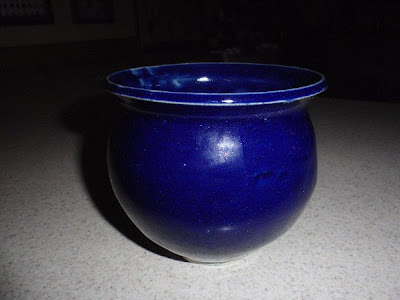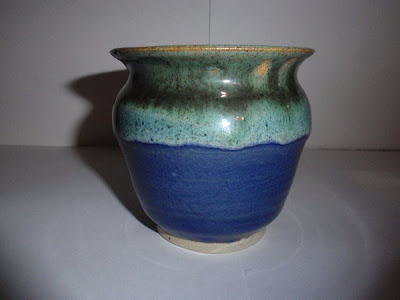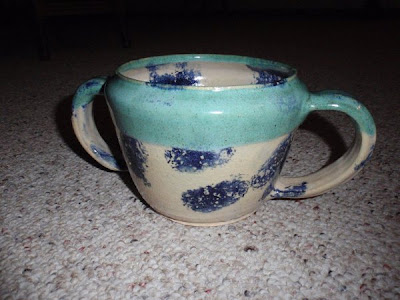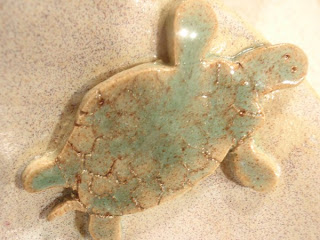Here is another project I didn't turn in. I think it has a nice shape though. The orange glaze is a mix of yellow and red.
Tuesday, June 8, 2010
Monday, June 7, 2010
Pitcher with mug
Projects with an obvious common art element constitute a set. This is a pitcher and mug set. The pitcher is 6.5 inches tall and 4 inches in diameter. The mug is 5.5 inches tall and 4.5 inches in diameter. They both have applied handles. The handle on the pitcher is only on the top half, but the mug's handle reaches from the lip nearly to the foot ring. The pitcher is glazed blue and dark green, split vertically into 2 approximately equal sections. The mug is glazed similarly but the dipping is angles and there are spots glazed only in clear as a result of masking tape. The dipping of the glaze and the same colors unites the projects, making them a set. Common elements make projects similar and related.
Plate
Color and glazing methods can evoke particular moods or associations from a viewer. This is a wheel made plate, seven inches in diameter and 1/2 inch tall. The lip is 'squared' off. The glaze is random dipping into brown, white, and dark green with clear over the whole plate except for a small irregularly shaped patch. Brown and green glazes in simple patterns create an earthy or natural appearance. Glaze color and style can create moods or be associated with another topic.
Wednesday, May 26, 2010
Two Piece
Three dimensionanal design accentuates the focal point of a project. This is a wheel made two piece bowl/pedestal. It is 8 inches tall and 8 inches at the lip. The top bowl is about twice the size of the base. There is a salmon cutout attatched to the top bowl. It protrudes about a quarter inch. The entire project is glazed clear and the fish is cherry red stain. The fish is the focal point of the project because of the accent color and also because it is a 3D element. Attatched features highlight design on a project.
Monday, May 24, 2010
Relationship Between Glaze and Form/Design
Many elements contribute to the overall appearance of a project, from glaze to form to surface design to negative space to pattern. The way ligth reflects off a project also determines how a project is regarded. In advanced ceramics during the second semester of my sophomore year, I have explored how certain aspects of a projet can be accented. The relationship between glaze and form or design determines what parts of projects are highlighted. My projects demonstrate how and why this occurs.
My collection is composed 6 pieces. A plate (http://3.bp.blogspot.com/_lQ6ODq-7pVk/S_sg0QK0WYI/AAAAAAAAAB4/SuVHTgRRCdY/s1600/P5240463.JPG) has random glaze on a regular shape, and as a result attention is drawn to the glaze design. A vase (http://2.bp.blogspot.com/_lQ6ODq-7pVk/S_sYgsEC_VI/AAAAAAAAABw/ssqIyv9X43Y/s1600/blue+vase.jpg) has a smooth, spherical belly and a simple, dark, and smooth glaze that highlights the form of the projet. A plate (http://3.bp.blogspot.com/_lQ6ODq-7pVk/S_sUDcwomaI/AAAAAAAAABY/OYZQU4o9uDk/s1600/plate+set+of+three.jpg) has random loops on it in blue stain and a runner that are highlighted over the form because of the specifiity of the design. A small vase (http://3.bp.blogspot.com/_lQ6ODq-7pVk/S_sTtPntjFI/AAAAAAAAABQ/yuvxsE4AM6o/s1600/bluegreen+vase.jpg) has highlighted color as a result of the complimentary colors and simple shape. A turtle bowl (http://2.bp.blogspot.com/_lQ6ODq-7pVk/S_sRwg1iRgI/AAAAAAAAAAo/adssosFB3Go/s1600/turtle+bowl.jpg) has an accented applicated figure becasue of a dull colored glaze on the whole project except for the turtle. Simple, light glaze brings attention elsewhere: to the turtle and turtle cutout. A mug (http://3.bp.blogspot.com/_lQ6ODq-7pVk/S_sOzAkR57I/AAAAAAAAAAY/JVqJXncakx8/s1600/mug.jpg) has surface design of two leaves that wrap around the body of the project. Dark glaze is in the surface design and this brings attention to the surface design, not glaze qualities or form. These projects all have a different art element that is highlighted becasue of different relationships between glaze and form.
Surface design, texture, patterns, glaze, reflections, and form all help determine how a project is viewed. I experimented with throwing techniques, glazing tehniques, and surface design in my ceramics endeavor. An over simplified shape with a solid, dull glaze creates a boring project, and an elaborate shape with surface design and busy glaze creates a chaotic, messy appearance. I prefer uniform shapes and strong, solid, bi- or tricolor glazing that hold a simple elegance or simple shapes with surface design and minimal glaze colors that highlight only the design. I had many projets come out no well because I oversimplified or tried to incorporate too many art elements at once. A balance is required to highlight one piece of the project and make it the dominant element, whether it is form of design or glaze.
One strong art element acompanied by simple other elements creates a balance in projects. The eye is drawn to highlighted sections and in this way the project is remembered. If too many parts are acented, the project is too busy and the eyes are confused about where to look, and the result is chaos. The highlighted element cannot be overpowering, but it has to be stronger than all the other parts of a projet to avoid a busy look. A certain balance is needed in all projects, strong characteristics need to be offset by weaker accompaniments. The mind seeks a balance in the world, and balanced projects are the most appealing.
Certain characteristics are accented because of the relationship between all of their art elements. I am drawn towards random glazes and surface design because they represent fragility of the present and change. The balance between glaze and form or surface design highlights one particular element, making a memorable and interesting project.
My collection is composed 6 pieces. A plate (http://3.bp.blogspot.com/_lQ6ODq-7pVk/S_sg0QK0WYI/AAAAAAAAAB4/SuVHTgRRCdY/s1600/P5240463.JPG) has random glaze on a regular shape, and as a result attention is drawn to the glaze design. A vase (http://2.bp.blogspot.com/_lQ6ODq-7pVk/S_sYgsEC_VI/AAAAAAAAABw/ssqIyv9X43Y/s1600/blue+vase.jpg) has a smooth, spherical belly and a simple, dark, and smooth glaze that highlights the form of the projet. A plate (http://3.bp.blogspot.com/_lQ6ODq-7pVk/S_sUDcwomaI/AAAAAAAAABY/OYZQU4o9uDk/s1600/plate+set+of+three.jpg) has random loops on it in blue stain and a runner that are highlighted over the form because of the specifiity of the design. A small vase (http://3.bp.blogspot.com/_lQ6ODq-7pVk/S_sTtPntjFI/AAAAAAAAABQ/yuvxsE4AM6o/s1600/bluegreen+vase.jpg) has highlighted color as a result of the complimentary colors and simple shape. A turtle bowl (http://2.bp.blogspot.com/_lQ6ODq-7pVk/S_sRwg1iRgI/AAAAAAAAAAo/adssosFB3Go/s1600/turtle+bowl.jpg) has an accented applicated figure becasue of a dull colored glaze on the whole project except for the turtle. Simple, light glaze brings attention elsewhere: to the turtle and turtle cutout. A mug (http://3.bp.blogspot.com/_lQ6ODq-7pVk/S_sOzAkR57I/AAAAAAAAAAY/JVqJXncakx8/s1600/mug.jpg) has surface design of two leaves that wrap around the body of the project. Dark glaze is in the surface design and this brings attention to the surface design, not glaze qualities or form. These projects all have a different art element that is highlighted becasue of different relationships between glaze and form.
Surface design, texture, patterns, glaze, reflections, and form all help determine how a project is viewed. I experimented with throwing techniques, glazing tehniques, and surface design in my ceramics endeavor. An over simplified shape with a solid, dull glaze creates a boring project, and an elaborate shape with surface design and busy glaze creates a chaotic, messy appearance. I prefer uniform shapes and strong, solid, bi- or tricolor glazing that hold a simple elegance or simple shapes with surface design and minimal glaze colors that highlight only the design. I had many projets come out no well because I oversimplified or tried to incorporate too many art elements at once. A balance is required to highlight one piece of the project and make it the dominant element, whether it is form of design or glaze.
One strong art element acompanied by simple other elements creates a balance in projects. The eye is drawn to highlighted sections and in this way the project is remembered. If too many parts are acented, the project is too busy and the eyes are confused about where to look, and the result is chaos. The highlighted element cannot be overpowering, but it has to be stronger than all the other parts of a projet to avoid a busy look. A certain balance is needed in all projects, strong characteristics need to be offset by weaker accompaniments. The mind seeks a balance in the world, and balanced projects are the most appealing.
Certain characteristics are accented because of the relationship between all of their art elements. I am drawn towards random glazes and surface design because they represent fragility of the present and change. The balance between glaze and form or surface design highlights one particular element, making a memorable and interesting project.
Plate
Contrast in shape within a projet can create a chaotic look. This is a whool made plate, 5.5 inches by .5 inches. It has a very regular, basic form. Gright yellow glaze is on the surface, randomly spread by tilting the plate. The random glaze is opposite the regular circular plate, eliciting a chaotic feeling. Contrast within projects often creates a disorganized look.
Blue Vase
Projects with mathematical inspired forms can look simple and effortless. This is a wheel made vase, 5 inches wide and 6 inches tall. The belly of the vase is spherical and smooth. The glaze is dark blue, shiny, and even. The spherical shape of the bowl makes it look simple yet elegant. Mathematical concepts in art create simple projets.
Tall Vase
Uneven glaze accentuates flaws in form. This is a wheel made vase, 8 inches tall and 4 inches in diameter at the lip. There are many sratches on the surface. The blue glaze is uneven and thin, and the flaws on the surface of the project are obvious. Even when the form of a projects is symmetrical and centered, scratches on the surface can make a projet look messy and poorly made. Glaze can either accentuate or camoflauge surface flaws in wheel projects.
Set of Three
A common element in many projects is regarded differently depending on accompanying features and glazes. This is a set of 3 projects with the common element of surface design. It is made of a plate, bowl, and simple cup/vase. THe plate has blue stain on it as a runner and random curves. The bowl has the same curves on it only. The vase has the curves on it, but instead of clear glaze it is glazed over in blue with shadow green on the lip. All three pieces have the random stain, but they appear differently according to the accompanying glaze. Random patterns are the focus of a project with no other significant features, but when with a contrasting glaze or more specific design, the random pattern is not the focus.
Extra Credit Vase
Glaze sits differently on a project depending on the angle of the surface. This is a wheel made vase, 5" by 3.5". Its shoulder is its widest part, adn the lip turns out nearly as far. The bottom 2/3 is glazed blue, and it is a very smooth, semi transparent glaze. The top 1/3 is shadow green. There is a small section of overlap that looks turquoise. The hue of the shadow green varies greatly across the project. Where the glaze sits on the project it is very dark, but places where it hangs off the wall it is a much lighter hue. The angle of the surface affects the way glaze sits on a project.
Large Vase (Choice)
Asymmetrical glaze on a symmetrical project draws away from form and towards the glze. This is a wheel made vase, 7.5 inches by 6 inches. It has a wide base. The shoulder and lip is slightly off center, which can been seen when the project is viewed at different angles. The glaze is blue stain sponged onto the surface randomly. The slight mistakes in the symmetry of the project are masked by random glazing. Glazing techniques can either highlight or draw attention away from a project's form.
Hand and Wheel
Glaze techniques can create the illusion of texture. This is a wheel made pot, 8 inches by 6.5 inches. It has two handles, opposite each other to create a symmetric project. This projest has blue stain sponged on ina random design. The lip is glazed shadow green. The sponged technique applied the stain unevenly, and as aresult the project appears textured. Glazing techniques can create the allusion of texture on a smooth project.
Turtle Bowl
Altered wheel projects can represent a story or a change in time. This is a wheel made bowl, 4 inches tall and 7 inches in diameter. There is a turtle shape cut out of the side of the bowl and another turtle shape applied to the other side in a different position. The majority of the bowl is glazed snad except for the turtle which has black stain in the cracks and shadow green over that. The mirrored turtle symbolizes time because it looks like the turtle 'crawled' out of the side of trhe bowl, leaving a hole, and is attempting to escape on the other side. Altered projects can show time or a story.
Small Vase
This is a wheel made vase, 4 inches tall and 4 inches in diameter. It has leaves carved into the outside and 'S' shaped curves on the inside lip. The leaves are glazed shadow green and the 'S' curves are red. The glaze in the carvings highlights the surface design; the leaves and curves would barely be visible without the glaze. Glazing techniques can show off small or delicate details in a project.
Leaf Mug
Large surface design that wraps around a project can give a two dimensional pattern a three dimensional appearance.This is a wheel made mug with a pulled handle. It is 6 inches high and has a 4 inch diameter. It has two leaves carved into the surface, an alder leaf and a maple leaf. The glaze is shadow green in the carvings, although it appears to be brown, and clear. The leaves wrap around the mug so they can't be seen all at once, and this shows the mug's shape. Surface design can appear three dimensional if it wraps around the surface of a project.
Subscribe to:
Posts (Atom)










